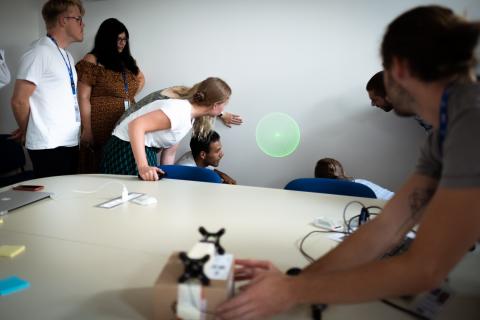From laser alignment to laser communication

CERN and Aircision, a CERN spin-off company, have signed an agreement for the application of a bespoke laser system developed for general alignment purposes in the context of the High Intensity and Energy ISOLDE (HIE-ISOLDE), a new superconducting linear accelerator that will upgrade CERN’s Isotope mass Separator On-Line (ISOLDE) radioactive beam facility. The Dutch start-up intends to use the technology, called Structured Laser Beam, using its ability of producing almost non-diffractive beams to empower future telecommunication frameworks.
As global data transfers are expected to increase tenfold from 2018 to 2024, the telecommunication infrastructure needs to scale up accordingly. However, available connecting technologies, such as microwaves and optical fibers, either require restrictive licenses or are expensive to deploy.
A possible alternative has emerged from the work developed by a team of CERN surveyors in collaboration with the Institute of Plasma Physics (IPP) in Prague. The result is a novel laser solution called Structured Laser Beam. “Although originally discovered during the development of an alignment system for the HIE-ISOLDE accelerator, the optical properties demonstrated by this technology show great potential for other high-precision applications, including free-space optical communications,” explains Miroslav Šulc (IPP), one of the two system inventors.
The Structured Laser Beam is unique because it is capable of generating almost non-diffractive laser beams. Such beams are composed of a central axis with very low divergence and tunable concentric rings. “The apparatus could be particularly valuable for aligning magnets at CERN, since the central axis of the laser measures only a few tenths of a millimeter in diameter even at very long distances, unlike currently available alignment solutions,” says Jean-Christophe Gayde, the second inventor and an engineer in the Experiment Survey and Alignment Section (Survey, Mechatronics and Measurements Group) of the Engineering Department at CERN.
The complete system is comprised of a coherent laser source (commercially available), a focusing element, and either a cylindrical or a spherical lens. It can be made extremely compact (to the size of a matchbox) and is easily adjustable for different scenarios. The lenses can be used with source lasers spanning a wide range of wavelengths; the beam geometry can be extensively tuned, as the diameter of the central axis and the number and thickness of the surrounding circles are adjustable.
Due to these characteristics, the structured laser beam shows great potential of deployment in a wide range of fields, from 3D and laser scanning to interferometry and even medical applications. “This system can provide solutions aligned with the technological needs of different markets”, explains Filipe Ramos, who works as a Knowledge Transfer Officer at CERN. “This flexibility played an immense role in securing resources for its development through the CERN Knowledge Transfer Fund, our internal funding mechanism for projects that have applications outside of high-energy physics.”
Aircision has recognized the value of this laser beam generator and is interested in applying it to the next-generation links in the telecom market. The final solution would ensure high-speed free-space optical communication between cell towers, which is a critical step towards modernizing the existing infrastructure for 5G and beyond.
“The collaboration is part of a wider effort by the Knowledge Transfer group to maximize the application of technologies developed at CERN and their positive impact in society,” explains Filipe Ramos. The start-up hopes to finalize their prototype and deploy a pilot test in 2020, and is already looking at other applications of the structured laser beam outside of telecommunications.
Article originally published in Accelerating News and the press release published by Aircision.
- Log in to post comments
